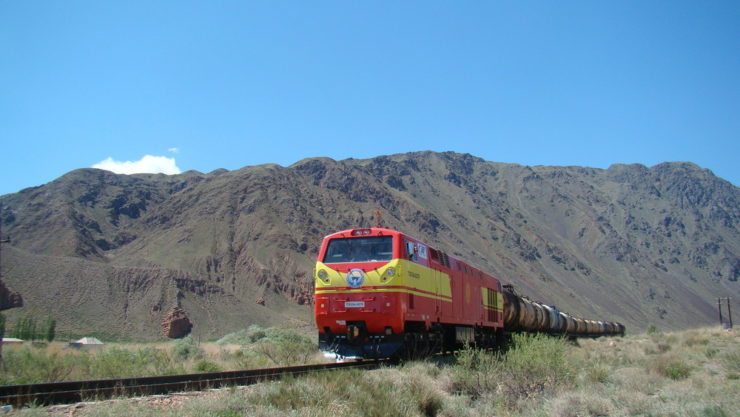
Kyrgyzstan’s railways currently consist of six sections connected to each other only through the territories of the neighbouring republics of Kazakhstan and Uzbekistan. In particular, we are talking about the longest northern section – about 300 kilometres from the border with Kazakhstan to Lake Issyk-Kul, as well as five short (a few dozen kilometres) sections, which are dead-end branches to major cities from the railway that runs in an arc through the Uzbek part of the Fergana Valley.
Such an original situation has developed due to the fact that all these lines were built during the Soviet era, when the administrative boundaries between the republics were nominal and in no way hindered the transport of goods and passengers. Now, after the collapse of the unified state, the task of establishing its own and interconnected railway network has gained serious importance for the young post-Soviet republic.
Currently, the republic’s authorities are striving to fulfil this task through the construction of the Balykchy-Karakeche railway. It is designed to connect the current northern section of the Kyrgyz railway with the prospective China-Kyrgyzstan-Uzbekistan international railway line. The construction of the latter is scheduled to begin this year – and was once again discussed in detail during a meeting of the Prime Ministers of Kyrgyzstan and Uzbekistan with a member of the Political Bureau of the CPC Central Committee and the Party Committee of the Xinjiang Uygur Autonomous Region of the People’s Republic of China, held on 1 March 2024 in Kashgar, China.
The length of the railway line under construction is 186 kilometres. It is worth noting that it also has a serious economic significance, as it will connect the large coal mines of Karakeche and Ming-Kush with the railway network of Central Asia. Also, the presence of the railway line in this area will create conditions for the implementation of a coal-fired CHP project with a capacity of 1200 MW, capable of providing electricity to 25% of the population of the Republic.
This railway project was developed in the early 2010s, and proposals for its creation were first voiced in the 1990s. However, the possibility of effective implementation of this project appeared soon after Kyrgyzstan managed to get Uzbekistan and China to accept the so-called “Northern Route” within the framework of the prospective China-Kyrgyzstan-Uzbekistan railway. While the “Southern Route”, connecting China and Uzbekistan almost in a straight line, would have required stretching the main line connecting the disconnected sections of Kyrgyz railways for almost 400 kilometres, the “Northern Route” reduced this distance to the current 189 kilometres. The final choice by the parties of an alternative favourable to Kyrgyzstan was announced in 2022. At the same time, construction of the Balykchy-Karakeche pipeline was started on 31 March 2022, although it was soon suspended until the end of the year.
Earlier in Kyrgyzstan it was supposed to attract Chinese specialists and investors to the project, but the parties could not come to a compromise solution due to Bishkek’s desire to reduce the cost of the project’s implementation relative to the estimates of Chinese companies.
The construction is being carried out in two stages – the first involves the construction of a 63-kilometre section from Balykchy to the town of Kochkor, and the second section will connect Kochkor directly to Karakeche. As of May 2024, work is underway on the first stage of the road.
The works related to the construction of this railway are planned to be completed by 2030. The project itself is reflected as a prospective project in the National Development Strategy of the Republic for 2018-2040. The completion date of construction roughly coincides with the planned completion of the China-Kyrgyzstan-Uzbekistan railway: hence, after completion of the works, the Balykchy-Karakeche railway can be connected to the railway networks of Uzbekistan and China, as well as to the Kyrgyz city of Jalal-Abad in the shortest possible time.
In theory, the Balykchy-Karakeche road has not only national but also international transit potential. In particular, it could potentially be of interest for cargo transit between Russia and China, as well as between China and Kazakhstan. In the first case, the road could be used to deliver cargo from China to Russia’s Trans-Urals and Western Siberia via Kazakhstan – with minimal load on Russian railway lines and a very competitive route in terms of length. For Kazakhstan, this line could also become a new road linking the south of the country with China – unlike existing routes and projects, the road via Balykchy and Bishkek will enter the territory of Kazakhstan to the west of the congested railway hub of Almaty. Nevertheless, the realisation of these advantages depends not only on the construction of this railway, but also on the progress of the China-Kyrgyzstan-Uzbekistan project, as well as on the general dynamics of growth of cargo volumes transported in these directions.
In addition to the projects mentioned above, Kyrgyzstan is also studying the possibility of building a railway from Balykchy to Tamchy, which would be an extension of the northern section: at present, Balykchy, from which the road to the south of the country runs from 2022, is the final station on this section. If this project is realised, the road will be extended along the northern shore of Lake Issyk-Kul, and may gain, among other things, an important tourist value.
Thus, the 2020s will be the era of Kyrgyzstan’s own railway network. Efforts to achieve this ambitious task for the small republic are limited to the promotion of the China-Kyrgyzstan-Uzbekistan railway project, as well as the creation of its own railway running from the north to the south of the country.
Bair DANZANOV, independent expert on Central Asia and Mongolia, especially for the online magazine “New Eastern Outlook“
